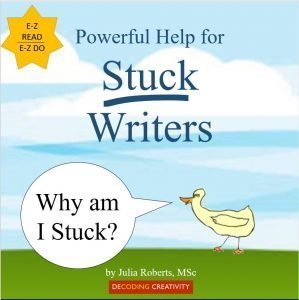
Today’s guest post is by writing and creativity coach Julia Roberts (@juliadecodes).
Despite its infamy for robbing people of their careers, writer’s block can give you a powerful gift—insight into your own relationship to the creative process.
Writer’s block is nothing more than a drain of energy when you come to a certain part of the process, and we all have natural ebbs and flows of energy as we move a project through its paces. So, think back. What part of your project were you on when you felt stymied?
Here are four possibilities, each tagged with a creative thinking style that we’ll discuss. Does one of these forms of writer’s block describe you?
- Maybe you love the research and inquiry phase, but get stuck when it’s time to write. (Clarifier)
- Maybe you have so many ideas, it’s hard to determine which idea is best for you. (Ideator)
- Maybe you can’t let it go; it needs a little more polishing. (Developer)
- Maybe you dash it off but later find sloppiness and errors in it, after getting it out into the world. (Implementer)
Yes, there is an easier way
When we think back to an episode of writer’s block—and mostly we don’t—we remember vats of ice cream or too much wine. We don’t remember the cause because that is what these coping mechanisms were designed to do—keep us from noticing a failing that is too painful to acknowledge. But take a look at the four possibilities above once more. Does one description fit you better than the others?
- Clarifier – You like to get it right.
- Ideator – You like ideas. You live in the possibilities.
- Developer – You like to get it perfect.
- Implementer – You like to get it done.
When you have a strong propensity for one phase of creativity—clarify, ideate, develop, or implement—you often lose energy and even obstruct creative progress in another phase. This creative phase and creative process research are based on the work of Dr. Gerard Puccio, the Department Chair and Director for the International Center for Studies in Creativity at Buffalo State College, part of the SUNY system. To test subjects for their creative thinking preferences, Dr. Puccio designed an assessment called Foursight.
My big learn
I took the Foursight assessment during my Master’s program at BuffState, and I had an enormous “a-ha” about my creative thinking style. I knew I had very high energy and skill for ideation. I’d been a professional brainstormer for most of my adult life. I’d go in, sit in a room with candy and toys, and blatt out ideas on one marketing project after another.
I could do it all day long. And I was in high demand and well paid for it. So, it was no surprise when my Foursight profile showed me as a high Ideator.
What was revealing is that I profiled as a very low Clarifier. I prefer to jump right in and not ask many questions. Furthermore, I was such a low Clarifier that I actually obstructed clarification. The very help I needed most, I didn’t value, and didn’t invite into my process. I got ideas, loved ideas. I lived in the idea zone where anything is possible. Clarity just harshed my thrill, right?
Though I couldn’t see it, what was happening was when I didn’t clarify, I didn’t commit. Or I’d commit to the wrong idea and just hop to a new one when the first one petered out. There’s always more ideas, right? I never took into account the amount of time lost because I hadn’t clarified or chosen my ideas thoughtfully.
I didn’t finish things I started because of the lack of commitment to any one idea. I know I’m creative, but I wasn’t managing to create, i.e., produce, enough of my ideas, and I didn’t know why. It was frustrating and sort of embarrassing. The Foursight assessment helped me see precisely why.
The Creative Selfie
Because that insight helped me immeasurably, I feel compelled to help writers see themselves in relation to their creative process strengths and struggles, and provide tools and support for areas where they need to bridge from one process phase to the next to bring their ideas to fruition. (I developed the Creative Selfie that I offer to all of my new clients; it includes the Foursight assessment plus two other tests to help you see quite clearly your creative gifts, and gaps, in 360 degrees.)
Consider how, armed with self-knowledge, you might be able to eradicate, prevent, prepare for, and survive writer’s block with your project intact. I learned to Clarify. In fact, I learned to value clarifying. I didn’t stomp my feet and roll my eyes when people tried to help me clarify. And with this one safeguard in place, I quit jumping from idea to idea. My life stopped going in circles—start, stop, start again—and started going in a straight line as my ideas were completed. I accumulated work, a foundation, on which to continue building.
Parting advice
Writer’s block can offer a powerful, even life altering gift of discovering your own style of creative thinking. Once you know, you can make choices. You can live only within your strength and hand off the rest of the process to your minions (which is what I did successfully as a professional brainstormer), or you can seek help and tools for your gaps.
 The pain of writer’s block is not just in the actual work stoppage but even more in the denial and fear that result, that leave us embarrassed, ashamed, helpless and maybe eating brownies in secret.
The pain of writer’s block is not just in the actual work stoppage but even more in the denial and fear that result, that leave us embarrassed, ashamed, helpless and maybe eating brownies in secret.
I hope you can look at your last writer’s block with more compassion and insight now, and separate the work stoppage from the stories you told yourself about why you stopped writing. Maybe you’re not lazy, crazy, stupid, or lame. Maybe you’ve just entered a creative phase that is not in your wheelhouse. There’s help for that.
Note from Jane: If you enjoyed this post, take a look at Julia’s Powerful Help for Stuck Writers (free with your email address).
Julia Roberts is a creativity coach who helps writers master their creative process and free themselves from the self-blame and judgment that can come from a lack of awareness of the creative process. She trained with Martha Beck and Eric Maisel, and has earned a Masters of Science in Creativity. Julia speaks on creativity at writers’ conferences (see her speaker’s reel) and has published three books, including Sex, Lies and Creativity – Gender Differences in Creative Thinking.

[…] much as we all hate writer’s block, it’s not always all bad. Julia Roberts explores why writer’s block is a gift, and Jami Gold suggests fighting writer’s block by focusing on stronger story […]
[…] Julia Roberts: Writer’s Block Is a Gift. Here’s Why. […]
When it comes to writer’s block, I use Ken kesey’s philosophy. It has never failed me! I’m 71 and very familiar with the counterculturist’s life style. No need to know how..When Ken wrote, One Flew Over The Coocoo’s Nest, he got writer’s block on the last chapter. He proceeded to smoke a bowl of Sativa strain cannabis and, Voila! The Indian just showed up. It was arguably the best chapter in the book! THC is a mind expanding substance! It obliterates writer’s block. Problem is, you never…….oh crap!
This breakdown is excellent – I’ve found some of my best writing comes AFTER I break through the “block”!